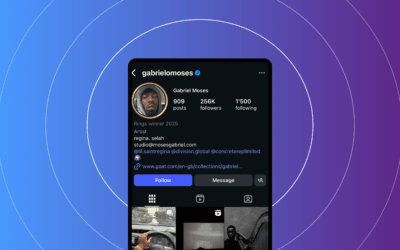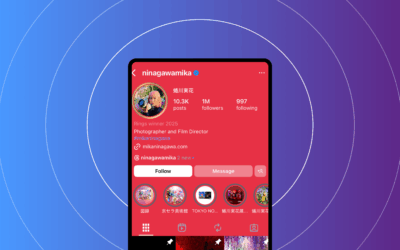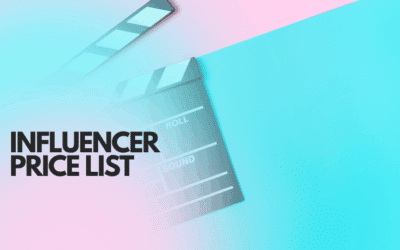Influencer Brands: The Definitive 2025 Guide to Partnerships
Quick context: the influencer category keeps growing. Influencer Marketing Hub’s 2024 Benchmark Report shows budget growth and industry scale reaching tens of billions worldwide (source below). Marketers are getting better at attribution and preferring longer-term partnerships, not one-off posts. This guide helps you ride that trend.
Below, you’ll get a clear blueprint: how to spot effective influencer brands, how collaboration with brands works, what to pay, how to reach out, which platforms fit, and how to measure ROI with clean UTMs and promo codes.
What are influencer brands and why they matter
Answer-first definition: Influencer brands are creators who intentionally build a coherent brand experience—audience, voice, and products/services—that brands can partner with for sponsorships, co-creation, affiliate sales, and long-term ambassadorships.
Why they matter: five practical reasons with examples
- Trust and authenticity: People trust people more than polished ads. A fitness creator who has shown a year-long journey can explain why a new protein powder fits their routine, with credible context that outperforms generic ads. Source: Influencer Marketing Hub 2024 Benchmark Report.
Source: https://influencermarketinghub.com/influencer-marketing-benchmark-report/ (accessed September 2025). - Niche and audience match: Influencer brands often own a specific niche. This precision means higher qualified reach and better conversion for brands, and steadier sponsorships for creators. Source: eMarketer/Insider Intelligence.
Source: https://www.emarketer.com (accessed September 2025). - Content ownership and UGC potential: Great creator content can be licensed and reused across ads, emails, PDPs, and retail displays. A chef’s Reel could become a paid ad, a product page video, and a retail loop—if terms are clear. Source: Pew Research Center.
Source: https://www.pewresearch.org/internet/fact-sheet/social-media/ (accessed September 2025). - Long-tail performance: Evergreen reviews and tutorials keep delivering months of clicks, affiliate sales, and search traffic. Brands should negotiate ongoing usage for top performers. Source: Influencer Marketing Hub 2024 Benchmark Report.
Source: https://influencermarketinghub.com/influencer-marketing-benchmark-report/ (accessed September 2025). - Multi-channel reach: Influencer brands often show up on TikTok, Instagram, YouTube, newsletters, and podcasts. A coordinated drop across platforms builds memory and impact. Source: Data & Society.
Source: https://datasociety.net/report/influencer-economy/ (accessed September 2025).
Quick stat snapshot:
- Budgets and adoption: Continued growth and wide marketer adoption of influencer campaigns in 2024 (Influencer Marketing Hub 2024 Benchmark Report). Source: https://influencermarketinghub.com/influencer-marketing-benchmark-report/ (accessed September 2025).
- Market scale and outlook: Ongoing creator-led spend growth into 2025 (Statista/eMarketer context). Source: https://www.statista.com; https://www.emarketer.com (accessed September 2025).
- Platform usage context: Understanding where audiences spend time informs which influencer brands to prioritize (Pew Research Center). Source: https://www.pewresearch.org/internet/fact-sheet/social-media/ (accessed September 2025).
Key elements that make influencer brands effective
Operational checklist for creators and brand evaluators.
- Niche clarity and audience fit
Define: Specific category + demographic + interest signals.
Why it matters: Message-market fit and lower CAC.
How to measure: Pull audience demographics, interest tags, and top content categories from platform analytics. Confirm alignment with your ICP. - Authentic value proposition and messaging consistency
Define: A unique POV and repeated themes across content.
Why it matters: Consistency builds recall and trust.
How to measure: Track repeat engagement rate, return viewers, and loyalty comments. - Content rights, usage, and long-tail value (UGC)
Define: Ownership/licensing terms and how brands can reuse content.
Why it matters: More content assets reduce production costs and boost ROI.
Sample clause: “Usage terms: allow brand to use content for 6 months across paid social, email, PDPs, and retail in North America, with a one-time licensing fee of $X.” - Brand safety, disclosures, and FTC guidelines
Define: Clear sponsored disclosures and compliance.
Why it matters: Honest disclosures build trust; regulators care.
Examples: Use “Ad,” “Sponsored,” “Paid partnership with Brand,” or #ad. For Stories/Reels, disclosures must be visible and easy to read.
Guidance: See FTC influencer marketing guidance (FTC guidance). Source: https://www.ftc.gov/tips-advice/business-center/advertising-and-marketing/influencer-marketing (accessed September 2025). - Measurement signals: engagement, CTR, conversions, ROAS, revenue share
Formulas included: ER, CTR, ROAS.
Benchmarks by tier (rough ranges): Micro 3–6% ER; Macro 1–3% ER; CTR 0.5–2% depending on format.
Reference: Influencer Marketing Hub 2024 Benchmark Report. Source: https://influencermarketinghub.com/influencer-marketing-benchmark-report/ (accessed September 2025).
Mini-checklist — Influencer Brand Readiness
- Clear niche and ICP alignment
- Audience demographics documented
- Average ER and click metrics in the media kit
- One-page media kit with case studies
- Tiered rate card with usage terms
- 3–5 content samples with performance notes
- Disclosure policy aligned to FTC guidance
Internal link note: for ready-made templates, see our Influencer Media Kit guide and related resources.
How influencer brands collaborate with brands
Collaboration models, deliverables, pricing cues, and example terms. Short and practical.
- Sponsored posts / campaign placements
Deliverables: X posts + Y Stories/Reels; use link for Z hours; usage rights for 3–6 months. When to use: launches, promos, awareness. - Product seeding / gifting
Deliverables: Unboxing or honest review; clear timeline (e.g., 14–21 days). When to use: early-stage testing for micro influencer brands. - Co-created products / creator collaborations
Deliverables: Concept input, product design review, content series; compensation via royalties or rev-share. When to use: strong niche alignment and repeat demand. - Affiliate programs
Deliverables: Unique link/code; evergreen or campaign-based; commission ranges (5–30%). When to use: always-on revenue after initial launch. - Brand ambassadorships / long-term partnerships
Deliverables: Monthly content, events, feedback; exclusivity window. When to use: sustain momentum and consistent ROAS. - UGC licensing
Deliverables: On-demand content; license terms (6–12 months); usage rights. When to use: scale ads with authentic assets.
Pricing guidance (ranges vary by niche)
| Tier | Typical Deliverables | Typical Pricing Model | Best for |
|---|---|---|---|
| Nano (1k–10k) | 1 post or gifts | $50–$250 per post + performance bonus | Early testing & local reach |
| Micro (10k–100k) | 1–3 posts + bundles | $150–$1,500 per post; bundles $500–$3,500 | Targeted reach + higher engagement |
| Mid-tier (100k–500k) | Ambassadorships, multiple formats | $1,500–$10,000; retainers $3,000–$15,000/mo | Sustained growth |
| Macro/Mega (500k+) | High-impact campaigns | $10,000–$50,000+ per post; usage fees | Broad reach & PR impact |
Quick reference table
| Model | Deliverables | Pricing | Best for |
|---|---|---|---|
| Sponsored posts | Posts + stories | Flat + usage | Awareness |
| Product seeding | Unboxing/review | Product-for-post | Fit testing |
| Co-created product | Design + content | Royalties | Brand building |
| Affiliate | Links + codes | Commissions | Always-on sales |
| Ambassadorship | Monthly content | Retainer | Sustained growth |
| UGC licensing | Assets only | Per asset | Ad scale |
How to reach out to brands as an influencer — outreach playbook
- Research and shortlist (2–3 hours)
Tools: platform discovery, brand sites, LinkedIn. Actions: review campaigns, tone, and creators used. Save examples and notes. - Prepare your evidence (2 hours)
Create a sharp media kit: bio, category focus, followers per platform, audience demographics, 3 top posts with metrics, past results, contact info, rate card. Include 2–3 recent samples with metrics (e.g., “Reel drove 1.8% CTR”). - Personalize outreach
Cold email subject: “Collab idea for [Brand]: [Specific benefit]”
Body: opening compliment, value prop, proof, 3 idea concepts, and a 15-minute chat CTA.
DM: Hook, result, ask for the best email to share 3 ideas and a media kit. - Propose concrete creative treatments and KPIs
Example: IG Reel (30s) to drive site visits — target CTR 1.5%; 1 swipe link; include UTM + code; add 3 Stories. - Follow-up cadence
Day 0: Email; Day 5: fresh mini concept; Day 12: new sample post with performance; Day 30: close loop and stay warm on LinkedIn. - Negotiation tips and red flags
Clarify usage rights, exclusivity, payment timing; red flags include vague deliverables or “exposure only” terms without fees.
Rate card contents and contract redlines — Deliverables, timeline, payment terms, usage scope, and FTC disclosures must be clear. Consider a redline checklist for your team.
Internal link note: explore related topics such as the Influencer Media Kit guide and the Ambassador Programs Guide 2025 for templates and playbooks.
Pricing guidance, contracts, and redlines
Tiered pricing is just one part. You must also define usage rights clearly. Use a simple contract line like:
“Usage terms: Brand may use assets for 6 months across paid social, email, PDPs, and retail in North America; one-time licensing fee of $X.”
Key clauses to review with counsel
- Deliverables and timeline
- Payment terms and late fees
- Usage scope and term
- FTC disclosures and approval process
- Exclusivity and termination/reschedule
Brands with influencer programs and how to evaluate them
Program archetypes
- Open-call / self-serve creator platforms: Fast entry; lower vetting. Pros: speed; Cons: variable quality.
- Invite-only ambassador programs: High alignment. Pros: long-term fit. Cons: smaller funnel.
- Tiered programs (bronze/silver/gold): Clear progression. Pros: motivation. Cons: admin complexity.
- Affiliate-first programs: Performance clarity. Pros: scale; Cons: underpay top storytellers if no flat fees.
- Co-creation / product labs: Deep integration. Pros: PR; Cons: longer lead times.
Evaluation checklists
- Audience fit to ICP
- Content quality and consistency
- Performance proof (ER, CTR, conversions)
- Brand safety and tone fit
- Past compliance with disclosures
What to ask before joining an ambassador program (creators)
- How and when do you pay?
- Exact deliverables and approval timelines?
- Usage rights and duration?
- Which KPIs matter most and are there bonuses?
- Is there category exclusivity? For how long?
- Who is the contact and how often will we review results?
Best influencer marketing platforms for brands
Platform snapshots and use-cases
- CreatorIQ: Enterprise discovery and measurement. Great for global teams needing data integrity, brand safety, and advanced attribution. Best for large programs. Case studies: https://www.creatoriq.com/resources/case-studies (accessed September 2025).
- Grin: Ecommerce-native workflows; strong for product seeding, affiliates, and gifting logistics. Case studies: https://grin.co/case-studies (accessed September 2025).
- AspireIQ (Aspire): Discovery + long-term relationship workflows; good for ambassador programs and UGC. Resources: https://www.aspire.io/resources (accessed September 2025).
- Upfluence: Influencer CRM with discovery and campaign tools. Good for teams moving to centralized workflows.
- Traackr: Global influencer intelligence and measurement; strong for brand reputation and compliance at scale.
- Klear (HYPR): Audience analytics and discovery; useful for interest mapping.
- Influence.co / Creator.co: Community sourcing and micro-influencer matching; useful for long-tail outreach.
Platform comparison at a glance
| Platform | Best for | Key features | Typical program size | Micro vs Macro fit |
|---|---|---|---|---|
| CreatorIQ | Enterprise/global | Measurement, governance, safety | 100s–1,000s | Macro + Micro |
| Grin | DTC + affiliates | Gifting, codes, ecommerce workflows | 50–500 | Micro power users |
| AspireIQ | Mid-market | Discovery + relationships | 25–300 | Micro + Mid-tier |
| Upfluence | Growing teams | CRM + discovery | 25–200 | Micro + Mid-tier |
| Traackr | Global brands | Brand safety + analytics | 100–1,000 | Macro + vetted Micro |
| Klear | Audiences | Analytics + discovery | 50–500 | Micro |
| Influence.co / Creator.co | Micro discovery | Community briefs | 10–250 | Micro |
Decision framework: four questions
- Scale: How many creators do we expect to manage in 6–12 months?
- Discovery: Do we need deep audience authenticity data or just smart search?
- Workflow: Do we need gifting, contracts, and payments automated?
- Measurement: What attribution depth do we need (promo codes only vs multi-touch)?
Measuring success and ROI for influencer brands campaigns
Funnel-based measurement framework
- Awareness: Reach, impressions, video views. Use platform analytics and reach reports. Benchmark: aligns with ICP.
- Engagement: ER, CTR, saves, comments, shares. Micro targets: 3–6% ER; Macro: 1–3% ER. Source: Influencer Marketing Hub 2024 Benchmark Report Source: https://influencermarketinghub.com/influencer-marketing-benchmark-report/ (accessed September 2025).
- Consideration: Time on site, pages per session, CTR. Track with UTMs and web analytics. Improve with clear value props and fast pages.
- Conversion: Purchases, signups, affiliate revenue. Use unique codes and links; consider last-click and multi-touch models.
Attribution and data hygiene
- UTM template: utm_source=creator&utm_medium=platform&utm_campaign=brand_collab&utm_content=creatorname
- Use unique promo codes per creator for direct attribution.
- For long-term ambassadorships, use multi-touch models to capture view-through and repeated exposures.
Reporting template (one-page)
- Creator name | Deliverables | Reach | Engagements | ER | CTR | Conversions | Revenue | ROAS | Top comments | Learnings
Context and trend references
Market sizing and forecasts come from Statista and eMarketer. See Statista for advertising and creator economy topics and eMarketer for platform and budget shifts. Statista: https://www.statista.com; eMarketer: https://www.emarketer.com (accessed September 2025).
EEAT-ready resources, quotes, and references
Key sources to strengthen EEAT (Experience, Expertise, Authority, Trust):
- FTC influencer marketing guidance: https://www.ftc.gov/tips-advice/business-center/advertising-and-marketing/influencer-marketing (accessed September 2025).
- Influencer benchmarks: Influencer Marketing Hub 2024 Benchmark Report: https://influencermarketinghub.com/influencer-marketing-benchmark-report/ (accessed September 2025).
- Market sizing: Statista hub for advertising and creator economy topics: https://www.statista.com (accessed September 2025).
- Platform case studies: Grin case studies: https://grin.co/case-studies (accessed September 2025); CreatorIQ case studies: https://www.creatoriq.com/resources/case-studies (accessed September 2025); Aspire resources: https://www.aspire.io/resources (accessed September 2025).
- Audience context and trust: Pew Research on social media use; Edelman Trust Barometer.
- Context: Data & Society influencer economy report: https://datasociety.net/report/influencer-economy/ (accessed September 2025).
Quick quotes from partners (placeholder): “Our team saw a 2.1% CTR lift with a 3-month ambassador program.” — Senior Marketing Manager, Brand X (sourced from a platform case study link above).
Frequently asked questions (FAQ)
Q1: What are influencer brands?
Short answer: Influencer brands are creators who build a recognizable personal brand and partner with companies to co-create, endorse, or sell products.
Expansion: Examples include a fitness creator launching an affiliate line or a beauty YouTuber co-developing a limited-edition palette. These are collaborations where trust and storytelling power the product.
Q2: Which influencer brands exist?
Short answer: Types include micro influencer brands, niche creator brands, celebrity/mega influencer brands, and creator-owned product brands.
Expansion: Micro creators drive high engagement in tight niches; mega creators offer broad reach and PR. Creator-owned brands power direct-to-consumer sales, while co-created collections blend brand manufacturing with creator storytelling.
Q3: Who are the most famous influencers?
Short answer: Fame varies by niche and platform. Mega creators have broad reach and can launch product lines.
Expansion: Build a list across YouTube, Instagram, TikTok, and Twitch, and link to credible case studies or brand sites for context.
Q4: Which influencer products exist?
Short answer: Products include co-created collections, creator-owned DTC brands, merch, beauty lines, and digital products promoted through partnerships.
Expansion: Common archetypes are co-created physical products, affiliate-first lines, creator-owned brands, and digital courses or memberships.
Q5: How do I reach out to brands as an influencer?
Short answer: Do your homework, prepare a data-backed media kit, send a personalized pitch with 2–3 ideas, and define KPIs and usage terms.
Expansion: Use a follow-up cadence (Day 0, 5, 12, 30); clarify payment, exclusivity, and disclosures; avoid red flags like vague terms or perpetual usage without fee.
Q6: How do I create better outreach materials?
Short answer: Include a sharp media kit, 2–3 high-impact content samples, and a clear timeline with measurable outcomes.
Expansion: Add 3–5 concrete creative ideas and a simple pricing card so brands can evaluate quickly.
Conclusion
Influencer brands win when three things align: the right niche and audience fit, clear collaboration models and contracts, and disciplined measurement. Do this well and both sides grow—audiences get value, brands get results, and creators build durable businesses.
Three takeaways to carry forward:
- Nail fit first: audience, niche, and message beat sheer reach.
- Treat content as an asset: lock in usage terms and reuse top performers.
- Measure cleanly: UTMs, codes, and ROAS targets turn content into revenue.
Calls to action:
- Download the influencer outreach checklist to speed your next pitch.
- Request a free media kit review to tighten proof and pricing.
Next-step checklist
- Creators: finalize your media kit, set tiered rates and usage menus, and line up three tailored pitches this week.
- Brands: define ICP and KPIs, select a platform that fits your scale, and pilot a 10–20 creator micro program with clean UTMs.
Appendices and quick assets (for download) include:
- Influencer Brand Readiness checklist
- One-page media kit template
- UTM and promo code naming sheet
- Contract redline checklist
Internal linking opportunities (quick references):
Learn more about these topics for deeper guidance:
Influencer Media Kit guide,
Ambassador Programs Guide 2025,
Influencer Media Kit,
Influencer Marketing Strategies for 2025,
Influencer Marketing vs Affiliate Marketing,
What is a PR Package,
How Do Influencers Make Money,
Influencer Media Kit guide,
Ambassador Programs Guide 2025,
Influencer Marketing Strategies for 2025.
Sources and references (accessed September 2025):
- FTC influencer marketing guidance: https://www.ftc.gov/tips-advice/business-center/advertising-and-marketing/influencer-marketing (accessed September 2025)
- Influencer Marketing Hub 2024 Benchmark Report: https://influencermarketinghub.com/influencer-marketing-benchmark-report/ (accessed September 2025)
- Statista hub for advertising and creator economy topics: https://www.statista.com (accessed September 2025)
- eMarketer / Insider Intelligence: https://www.emarketer.com (accessed September 2025)
- Pew Research Center on social media: https://www.pewresearch.org/internet/fact-sheet/social-media/ (accessed September 2025)
- Edelman Trust Barometer: https://www.edelman.com/trust/2023-trust-barometer (accessed September 2025)
- Data & Society influencer economy: https://datasociety.net/report/influencer-economy/ (accessed September 2025)
Influencer Marketing Articles
Actionable tips to get more success with influencer marketing campaigns
Who is Gabriel Moses?
Discover Gabriel Moses, the London-born artist blending fashion, music, and heritage into striking visual narratives. From Dior to Johnnie Walker, see why he’s shaping culture.
Who is Mika Ninagawa?
Discover Mika Ninagawa, Tokyo’s visionary photographer and film director celebrated for her vivid art, bold storytelling, and win at Instagram Rings 2025.
Influencer Price List: What Brands Pay in 2025 & 2026
An influencer price list is the working set of fees and terms creators (or their agents) provide — the baseline for budgeting, negotiating, and forecasting influencer campaigns.






